VIII.2.39 Pompeii. Casa di
Giuseppe II or Casa di Fusco or House of Emperor Joseph II.
Linked to VIII.2.38. Excavated 1750, 1767, 1769, 1826, 1884 and 1928.
Part 1 Part 2 Part 3
Part 4 Part 5 Part 6
Plan

Via della Regina,
Pompeii. December 2018.
Looking west along south side of roadway from VIII.2.39, on left.
Photo courtesy of Aude Durand.

VIII.2.39 Pompeii. December 2006. Front wall in Via della Regina, looking west.

VIII.2.39 Pompeii. May 2024. Looking south-east to entrance doorway on
Via della Regina. Photo courtesy of Klaus Heese.

VIII.2.39 Pompeii. December 2004. Entrance doorway.


VIII.2.39 Pompeii. October 2023.
Looking south towards atrium from entrance doorway. Photo courtesy of
Klaus Heese.

VIII.2.39 Pompeii. September 2019. Looking
south across room b, atrium, from room a, fauces.
Foto Annette Haug, ERC Grant 681269 DÉCOR.

VIII.2.39 Pompeii. December 2004. Looking south across room b, atrium, from room a, fauces.

VIII.2.39 Pompeii. September 2019. Looking south across impluvium
in atrium room b.
Foto Annette Haug, ERC Grant 681269 DÉCOR

VIII.2.39 Pompeii. May 2006. Looking south across impluvium in atrium, room b.


VIII.2.39 Pompeii. July 2017. Found 22nd July 1769. Wall painting of banquet scene in a colonnaded room.
Now in Naples Archaeological Museum. Inventory number 8968.
Foto Annette Haug, ERC Grant 681269 DÉCOR.

VIII.2.39 Pompeii. Found 22nd July 1769. Wall painting of banquet scene in a colonnaded room.
Now in Naples Archaeological Museum. Inventory number 8968.
This was previously (apparently wrongly) identified as the death of Sophonisba or as Scipio and Sophonisba.
See Real Museo Borbonico, Vol. 1, Ta XXXIV.
See Helbig, W., 1868. Wandgemälde der vom Vesuv verschütteten Städte Campaniens. Leipzig: Breitkopf und Härtel. (1385)

VIII.2.39 Pompeii. Found 22nd July 1769. Detail of figures in wall painting of banquet scene.
Now in Naples Archaeological Museum. Inventory number 8968.
![VIII.2.39 Pompeii. Pre-1843. Drawing of banqueting scene, previously identified as “Le Nozze di Sofonisba e Massinissa”.
See Raccolta de più interessante Dipinture e di più belle Musaici rinvenuti negli Scavi di Ercolano, di Pompei, e di Stabia. 1843. Napoli.
According to Kuivalainen, in the left intercolumnium is a bearded robed male with a thyrsus in his left arm [Bacchus].
In the right intercolumnium there is a naked male raising his right hand with an arrow and holding a bow in his left [Apollo].
Both are wreathed and presented in ¾ profile.
The statues of Bacchus and Apollo [Left and right in the background] refer to the Hellenistic multiculturalism in northern Africa, even to the honourable afterlife.
Orphic text refer to Apollo as the resurrector of Dionysus.
See Kuivalainen, I., 2021. The Portrayal of Pompeian Bacchus. Commentationes Humanarum Litterarum 140. Helsinki: Finnish Society of Sciences and Letters, (p.87, A11, note 373).](8%2002%2039%20p1_files/image020.jpg)
VIII.2.39
Pompeii. Pre-1843. Drawing of banqueting scene, previously identified as “Le
Nozze di Sofonisba e Massinissa”.
See Raccolta de più
interessante Dipinture e di più belle Musaici rinvenuti negli Scavi di
Ercolano, di Pompei, e di Stabia. 1843. Napoli.
According
to Kuivalainen, in the left intercolumnium is a bearded robed male with a
thyrsus in his left arm [Bacchus].
In the
right intercolumnium there is a naked male raising his right hand with an arrow
and holding a bow in his left [Apollo].
Both
are wreathed and presented in ¾ profile.
The statues
of Bacchus and Apollo [Left and right in the background] refer to the
Hellenistic multiculturalism in northern Africa, even to the honourable
afterlife.
Orphic
text refer to Apollo as the resurrector of Dionysus.
See Kuivalainen, I., 2021. The Portrayal of Pompeian Bacchus. Commentationes Humanarum Litterarum 140. Helsinki: Finnish Society of Sciences and Letters, (p.87, A11, note 373).

VIII.2.39 Pompeii. September 2019.
Looking
towards north side of atrium, with entrance corridor, in centre, with doorways
to room c and d, on right.
On
the left is the doorway to room n, followed by room d’, against the north wall
on the west side of entrance corridor.
Foto
Annette Haug, ERC Grant 681269 DÉCOR

VIII.2.39 Pompeii. September 2019. Doorway to room c on east side
of entrance corridor.
Foto Annette Haug, ERC Grant 681269 DÉCOR

VIII.2.39 Pompeii. September 2019. Doorway threshold, looking
north into room c.
Foto Annette Haug, ERC Grant 681269 DÉCOR

VIII.2.39 Pompeii. September 2019. Room c, looking north across
flooring.
Foto Annette Haug, ERC Grant 681269 DÉCOR

VIII.2.39
Pompeii. c.1930. Room c.
According to Blake, the flooring of this room had its rectangular centre filled with the imbrication and framed in a meander which lies like a carpet on the dotted field.
See Blake, M., (1930). The pavements of the Roman Buildings of the
Republic and Early Empire. Rome, MAAR, 8, (p.26 & Pl.3, tav.4).

Room c, cubiculum, flooring in
cocciopesto with “carpet” of scales edged with alternating meanders and
squares, located into the flooring of white tesserae in regular lines.
DAIR 40.374. Photo © Deutsches
Archäologisches Institut, Abteilung Rom, Arkiv.
See Pernice, E. 1938. Pavimente und Figürliche Mosaiken:
Die Hellenistische Kunst in Pompeji, Band VI. Berlin: de Gruyter, (taf. 12.1)

VIII.2.39
Pompeii. Sketch by G Discanno, seen on the rear wall of room c.
DAIR 83.180. Photo © Deutsches Archäologisches Institut,
Abteilung Rom, Arkiv.
See Bullettino
dell’Instituto di Corrispondenza Archeologica (DAIR), 1887 p. 115, 2.

VIII.2.39
Pompeii. Sketch by G Discanno, seen on a wall in room c.
DAIR 83.181. Photo © Deutsches Archäologisches Institut,
Abteilung Rom, Arkiv.
See Bullettino
dell’Instituto di Corrispondenza Archeologica (DAIR), 1887 p. 115, 3.

VIII.2.39 Pompeii. May 2006. Lararium niche in small room c, in north-east corner of atrium.
This was painted red with a genius in a toga, holding a cornucopia and standing to the left of a round altar.
To the right was a figure in blue and yellow with a diadem and sceptre in the left hand and a patera in the outstretched right hand.
This was possibly Juno.
See Fröhlich, T., 1991. Lararien
und Fassadenbilder in den Vesuvstädten. Mainz: von Zabern. (p. 291, L95, T:44,1).
See
Boyce G. K., 1937. Corpus of the
Lararia of Pompeii. Rome:
MAAR 14. (p. 75, no. 349, pl.19,2).
See Giacobello, F., 2008. Larari Pompeiani: Iconografia e culto dei Lari in ambito domestico. Milano: LED Edizioni. (p.197 incl: drawing by Discanno)

VIII.2.39 Pompeii. 19th century drawing by G. Discanno. Lararium niche in small room c, east wall.
DAIR
35.501. Photo © Deutsches Archäologisches Institut, Abteilung Rom, Arkiv.
Genius with cornucopia extending his hand towards a round altar.
A woman, with blue chiton and yellow mantle and diadem on her head, holds a sceptre in her left hand and a patera in her right.
This is Juno, the female corresponding to the Genius.
See
Carratelli, G. P., 1990-2003. Pompei:
Pitture e Mosaici. Roma: Istituto della enciclopedia
italiana, p.
314-5.

VIII.2.39 Pompeii. Statue of Harpocrates found in the lararium.
Now in Naples Archaeological Museum. Inventory number 5329.
See Ward Perkins, J. and Claridge A., 1976. Pompeii AD 79. London: Westerham. (T:191).

VIII.2.39 Pompeii. April 2019. Room c. Coppe su piede ad anello. (Cup with ring-foot).
The green glazed relief has Mercury leading a running horse and Hercules fighting the Hydra. Photo courtesy of Rick Bauer.
Now in Naples Museum, Inventory number 116617.
Described as “from first room to the left of the atrium, probably part of the cult equipment of the lararium, of which were found a masonry structure and a tufa altar.”
See
Notizie degli Scavi di Antichità, 1885, p.535-38.
See
Di Gioia, E. (2006). La ceramica invetriata in area vesuviana: SAP 19.
“L’Erma” di Bretschneider, (p.35, figs.16-18).

VIII.2.39 Pompeii. May 2006. Doorways to rooms c and d, in north-east corner of atrium.

VIII.2.39
Pompeii. September 2019.
North-east
corner of atrium, between doorways of rooms c and d.
Foto
Annette Haug, ERC Grant 681269 DÉCOR

VIII.2.39 Pompeii. September 2019.
Foto Annette Haug, ERC Grant 681269 DÉCOR
According to PPM –
“The
ancient wall in north-east corner of atrium with large blocks of Sarno stone,
in which was inserted a quarter of a Corinthian tufa column covered with
white stucco on a red square base.
This motif was repeated in the other corners of the atrium and, with similar semi-columns, at the entrances of the alae, which were associated with the I style decoration, making this one of the most majestic atriums of Pompeii.”
See Carratelli, G. P., 1990-2003. Pompei: Pitture e Mosaici. VIII (8). Roma: Istituto della enciclopedia italiana, (No.4, p.313).

VIII.2.39 Pompeii. May 2006. North-east corner of atrium, wall between doorways of rooms c and d.

VIII.2.39
Pompeii. September 2019. Room d, looking north-east from doorway.
Foto
Annette Haug, ERC Grant 681269 DÉCOR

VIII.2.39 Pompeii. May 2006. East side of atrium with doorways to rooms e, f and g, east ala. Looking south-east.

VIII.2.39 Pompeii. September 2019.
Doorway to room e, on east side of atrium.
Foto
Annette Haug, ERC Grant 681269 DÉCOR

VIII.2.39 Pompeii. September 2019. Room e, looking east along
north wall.
Foto Annette Haug, ERC Grant 681269 DÉCOR

VIII.2.39 Pompeii. September 2019. Doorway to room f, on east side
of atrium.
Foto Annette Haug, ERC Grant 681269 DÉCOR

VIII.2.39 Pompeii. September 2019. Room f, looking east across
flooring.
Foto Annette Haug, ERC Grant 681269 DÉCOR

VIII.2.39 Pompeii. September 2019. Room f, detail of flooring near
north wall.
Foto Annette Haug, ERC Grant 681269 DÉCOR
According to PPM –
“The flooring was in cocciopesto with a net of hexagons juxtaposed
with a swastika in the centre; the marginal border consisted of scattered
tesserae.”
See
Carratelli, G. P., 1990-2003. Pompei:
Pitture e Mosaici. Roma: Istituto della enciclopedia italiana, (no.11,
p.316).

VIII.2.39 Pompeii. c.1930. According to Pernice, this
photograph of the flooring is from Cubiculum “f”.
According to PPM, the photograph is from Cubiculum l (L).
Flooring in cocciopesto, in the border
are flakes of tesserae, in the “carpet” is a net of meanders and squares with a
central black dot.
DAIR 40.376. Photo © Deutsches Archäologisches Institut, Abteilung Rom,
Arkiv.
See Pernice, E. 1938. Pavimente
und Figürliche Mosaiken: Die Hellenistische Kunst in Pompeji, Band VI.
Berlin: de
Gruyter, (taf. 12.3)
(This certainly would seem to agree with the floor decoration and damage in the south-west corner of room l (L), so must agree that PPM is correct and Pernice erred. PPM also describe the flooring in cubiculum “f” as seen in the photo above this one, taken by Annette Haug.
Thanks to Annette Haug for spotting the differences, and the identification.)

VIII.2.39 Pompeii. Sketch by G Discanno, seen on the rear wall of
room f.
DAIR 83.176. Photo ©
Deutsches Archäologisches Institut, Abteilung Rom, Arkiv.

VIII.2.39 Pompeii. Sketch by G Discanno, seen on the entrance wall
of room f.
DAIR 83.177. Photo ©
Deutsches Archäologisches Institut, Abteilung Rom, Arkiv.

VIII.2.39 Pompeii. September 2019. East ala g, looking east in
south-east corner of atrium.
Foto Annette Haug, ERC Grant 681269 DÉCOR

VIII.2.39 Pompeii. September 2019. East ala g, north wall with
doorway into room f.
Foto Annette Haug, ERC Grant 681269 DÉCOR

VIII.2.39 Pompeii. September 2019.
East ala g, north side, with doorway in north wall into room f,
from south-east corner of atrium.
Foto Annette Haug, ERC Grant 681269 DÉCOR

VIII.2.39 Pompeii. May 2006. Edge of doorway to room g, east ala in south-east corner of atrium.

VIII.2.39 Pompeii. September 2019.
East ala g, looking towards south wall, with doorway to room t/u,
on right.
Foto Annette Haug, ERC Grant 681269 DÉCOR

VIII.2.39 Pompeii. September 2019. Upper semi-column in south wall
of east ala g.
Foto Annette Haug, ERC Grant 681269 DÉCOR

VIII.2.39 Pompeii. September 2019.
South wall of east ala g, capital above semi-column in south-east
corner of atrium.
Foto Annette Haug, ERC Grant 681269 DÉCOR

VIII.2.39 Pompeii. September 2019. East ala g, detail from south
wall in south-east corner.
Foto Annette Haug, ERC Grant 681269 DÉCOR

VIII.2.39 Pompeii. May 2006. West side of atrium, looking south.
Doorways to room q, andron/corridor, room h, ala, and rooms k and l, on west side of atrium.

VIII.2.39 Pompeii. October 2023.
South-west corner of atrium, looking towards south wall of room h, ala.
Photo courtesy of Klaus Heese.

VIII.2.39 Pompeii. September 2019. West ala h, looking towards
south wall with window to room p.
Foto Annette Haug, ERC Grant 681269 DÉCOR
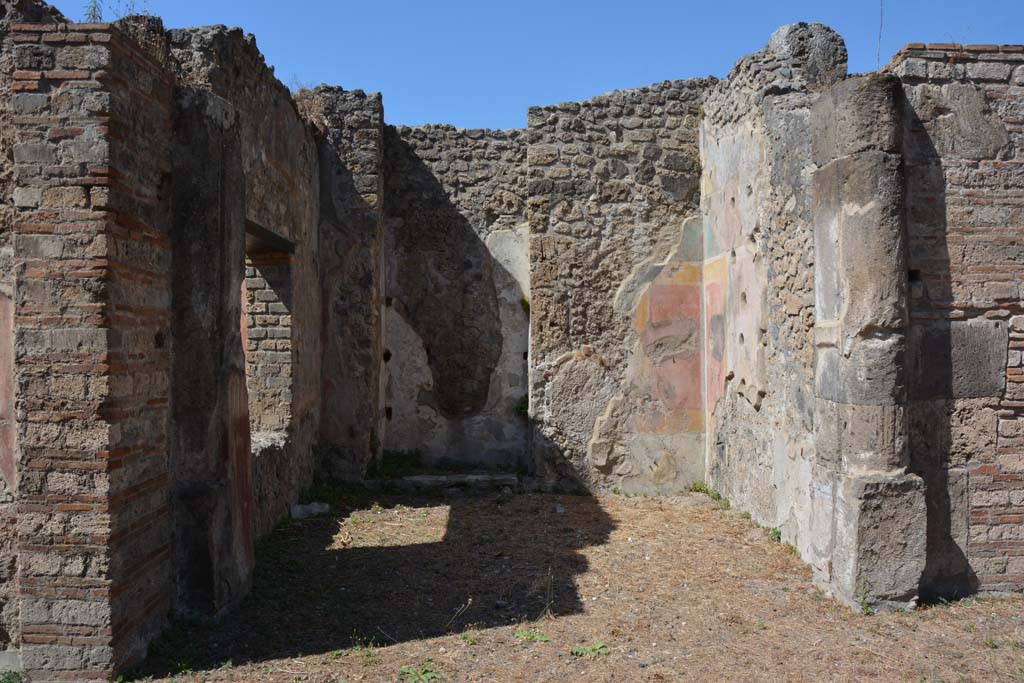
VIII.2.39 Pompeii. September 2019. West ala h, looking west in
south-west corner of atrium.
Foto Annette Haug, ERC Grant 681269 DÉCOR

VIII.2.39 Pompeii. September 2019. West ala h, looking towards
north wall.
Foto Annette Haug, ERC Grant 681269 DÉCOR

VIII.2.39 Pompeii. September 2019.
Looking north along west side of atrium, west ala h, on left, followed by doorways to rooms k. l (L), m, n and d.
Foto
Annette Haug, ERC Grant 681269 DÉCOR

VIII.2.39 Pompeii. May 2006.
Room h, ala on west side of atrium, on left, and doorway to room k, with shelving supports on west wall, on right.
According to Schefold, found in the west ala were damaged landscapes showing Isis temple, and another with statue of Priapus.
See Schefold, K., 1962. Vergessenes Pompeji. Bern: Francke. (Fig.152,1 and 2)
According to Jashemski, there was a garden representation in the right (west) ala, under the painting of an Egyptian landscape.
This she described as being a herm of Silvanus in the middle of the garden.
Drawing of garden representation in the DAI, Rome, negative no: 53504
See Jashemski, W. F., 1993. The Gardens of Pompeii, Volume II: Appendices. New York: Caratzas. (p.401 and Fig.494)

VIII.2.39 Pompeii. 19th century drawing by G. Discanno. From the Ala (h), north wall.
Scene of offering and sacrifice near a temple in front of which is a seated statue of Isis.
A statue of a youth on a high rectangular base and a statue of a female in draped dress are at her side.
DAIR 53.503. Photo © Deutsches Archäologisches
Institut, Abteilung Rom, Arkiv.
See Carratelli, G. P., 1990-2003. Pompei: Pitture e Mosaici. Roma: Istituto della enciclopedia
italiana, p. 323.

VIII.2.39 Pompeii. 19th century drawing by G. Discanno. From Ala (h), lower north wall below centre panel.
Garden scene with two women dedicated to plant care. In the centre is a herm of Priapus with his robe lifted and full of fruit
DAIR 53.504.
Photo © Deutsches Archäologisches Institut, Abteilung Rom, Arkiv.
See Carratelli,
G. P., 1990-2003. Pompei: Pitture e Mosaici. Roma: Istituto della enciclopedia italiana, p. 323.

VIII.2.39 Pompeii. c.1930. Flooring from right ala (h), as elaborated as any design ever attempted in this class of floor.
According to Blake –
To the meander threshold, the dotted field and the meander frame, has been added a central square, containing an elaborate rosette enclosed in a circle, with graceful floral motives between the circle and the square.
See Blake,
M., (1930). The pavements of the Roman Buildings of the Republic and Early
Empire. Rome, MAAR, 8, (p.26 & Pl.3, tav 3).

VIII.2.39 Pompeii. c.1930. Room
“h”, the west ala, detail of flooring of “graceful floral motif”.
DAIR 40.378. Photo ©
Deutsches Archäologisches Institut, Abteilung Rom, Arkiv.
See Pernice,
E. 1938. Pavimente und Figürliche
Mosaiken: Die Hellenistische Kunst in Pompeji, Band VI. Berlin: de Gruyter,
(taf. 12.5)

VIII.2.39 Pompeii. September 2019. Doorway
to room k, on west side of atrium.
Foto Annette Haug, ERC Grant 681269 DÉCOR

VIII.2.39 Pompeii. September 2019. Room k,
looking west from doorway.
Foto Annette Haug, ERC Grant 681269 DÉCOR

VIII.2.39
Pompeii. September 2019. Room k, detail of flooring.
Foto
Annette Haug, ERC Grant 681269 DÉCOR
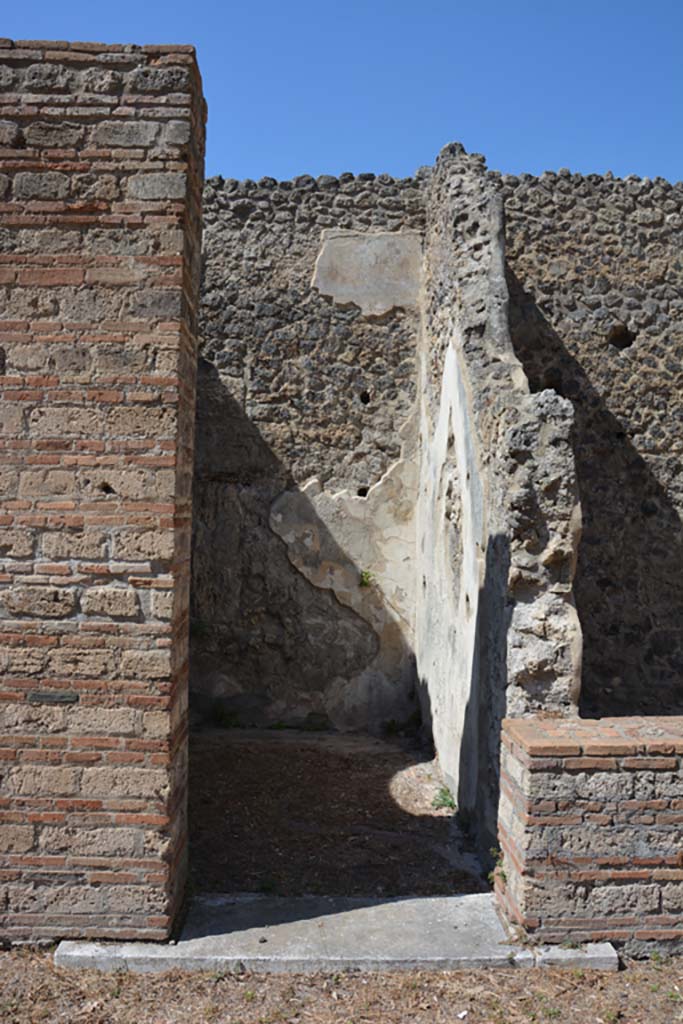
VIII.2.39 Pompeii. September 2019. Doorway
to room l (L) on west side of atrium.
Foto Annette Haug, ERC Grant 681269 DÉCOR

VIII.2.39 Pompeii. September 2019. Room l
(L), looking west from doorway.
Foto Annette Haug, ERC Grant 681269 DÉCOR
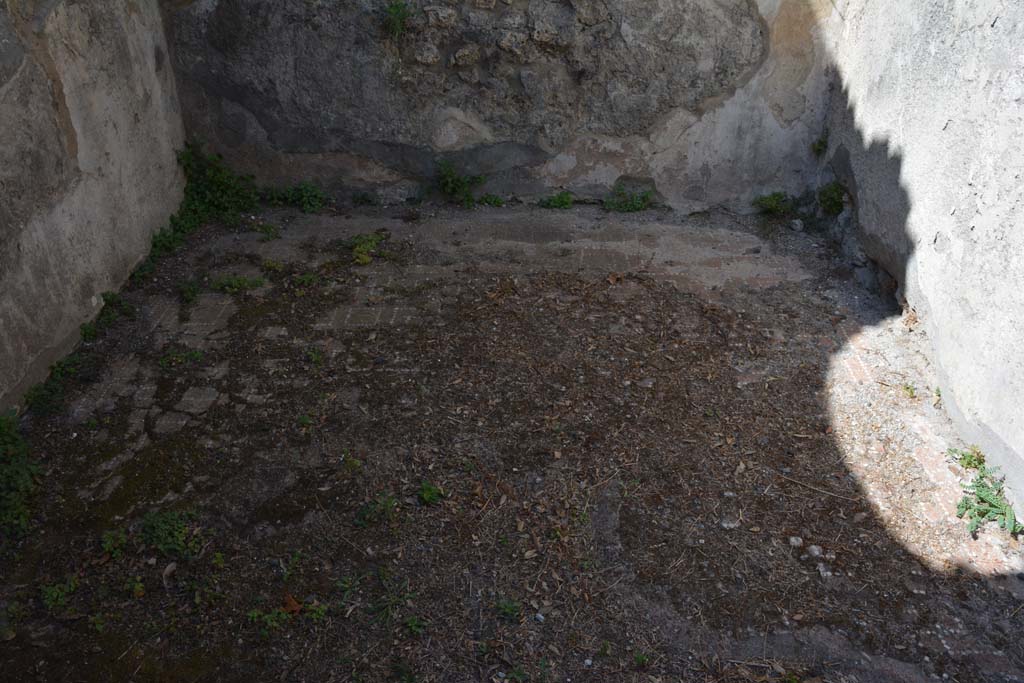
VIII.2.39 Pompeii. September 2019. Room l
(L), looking west across flooring.
Foto Annette Haug, ERC Grant 681269 DÉCOR

VIII.2.39 Pompeii. September 2019. Room l
(L), detail of flooring near east wall.
Foto Annette Haug, ERC Grant 681269 DÉCOR
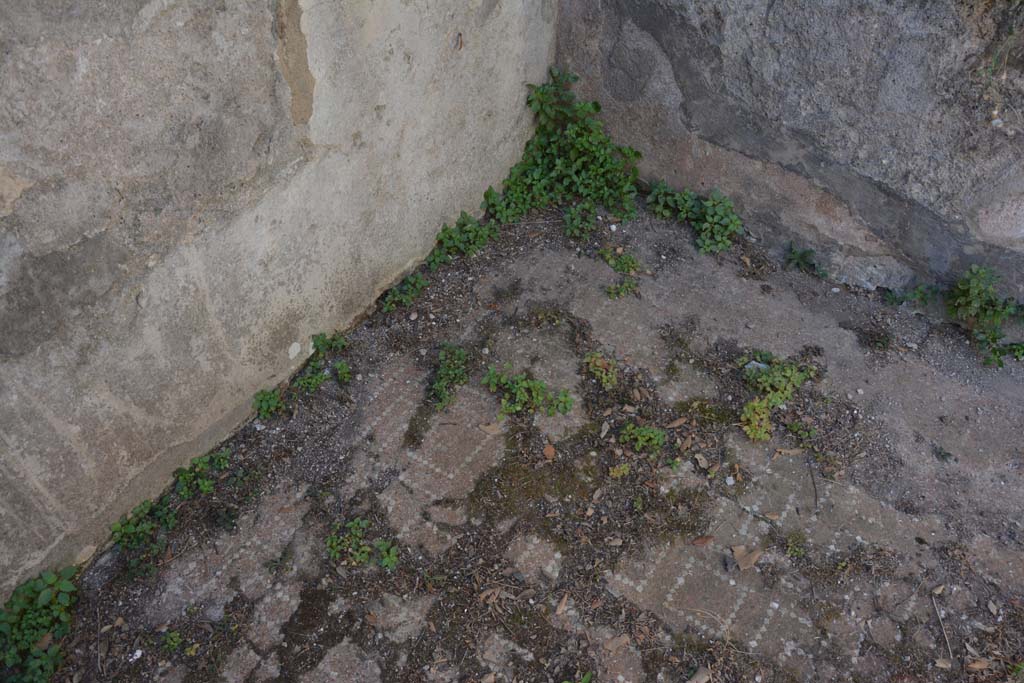
VIII.2.39
Pompeii. September 2019. Room l (L), flooring in south-west corner.
Foto
Annette Haug, ERC Grant 681269 DÉCOR

According to PPM, the photograph is from
Cubiculum l (L).
Flooring in cocciopesto, in the border are
flakes of tesserae, in the “carpet” is a net of meanders and squares with a
central black dot.
DAIR 40.376.
Photo © Deutsches Archäologisches Institut, Abteilung Rom, Arkiv.
See Pernice, E. 1938. Pavimente
und Figürliche Mosaiken: Die Hellenistische Kunst in Pompeji, Band VI.
Berlin: de Gruyter, (taf. 12.3)
(This certainly would seem to agree with the floor decoration and damage in the south-west corner of room l (L), so must agree that PPM is correct and Pernice erred. Thanks to Annette Haug for spotting the similarity.)
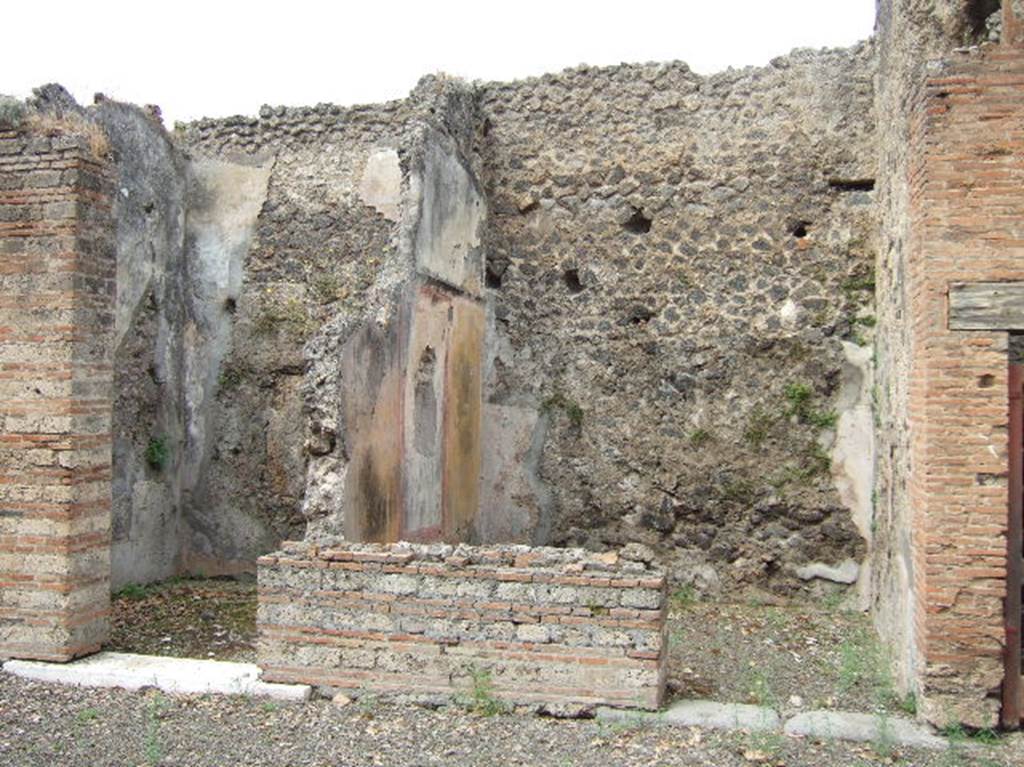
VIII.2.39 Pompeii. May 2006. Doorways to rooms l (L) and m, on west side of atrium.
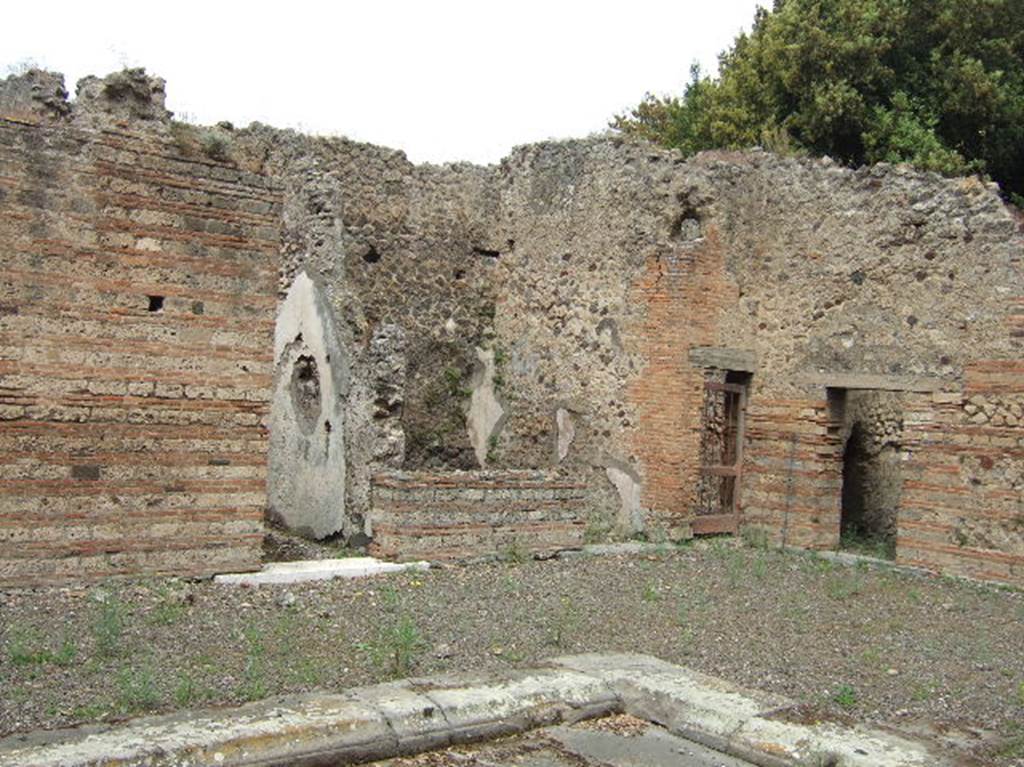
VIII.2.39 Pompeii. May 2006. Doorways to rooms l, m, n and kitchen d’, in north-west corner of atrium.
Part 2 Part 3
Part 4 Part 5 Part 6
Plan